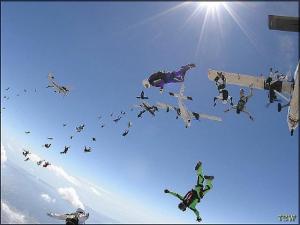The author is a member of a team of skydivers over forty years of age that recently completed a world record of 113 skydivers joined in formation.
When I tell people what I do for fun, the typical responses vary from “You’re very brave” to “You’re crazy!” What’s my hobby? I hurl myself out of airplanes. The bigger the plane, and the higher the altitude, the better.
Countless times people have asked me why I would jump out of a “perfectly good airplane”. Skydivers deal with this sort of reaction all the time. We’re often perceived as daredevils or even as exhibiting some sort of death wish. Yes, many of us are indeed delightfully what you would call “crazy” but very few of us are reckless and none of us wants to die. On the contrary, we love life and that’s why we skydive.
Ever since I was a little girl, I wanted to fly. This was no passing childhood fantasy, it was an obsession. At the age of seven, I saw some military footage of a paratrooper in freefall and realized that THIS would be the means by which I would fulfill my dream: by exiting an aircraft with nothing but a parachute on my back. In the meantime, school and piano lessons dominated my life as I pursued a future in music. My dreams while sleeping were frequently dominated by scenes of overcoming gravity and floating above the earth.
In university, the demands of studying as well as the tightening of the purse strings put my dreams of flight on hold. Three university degrees later, with a “real job” under my belt, the demands of teaching music classes and performing concerts (I’m a classical pianist) took over my life. Jumping from an airplane was still one of those unfulfilled promises to myself. And now that I was older, presumably wiser, and much more aware of my own mortality, I even wondered whether I’d have the courage to drop from several thousand feet above the ground.
My dream came true suddenly and unexpectedly. Skydiving was the last thing on my mind on a summer day in July of 1992. The college in Alberta where I was working had terminated part of its music program and I was faced with the heartbreaking prospect of leaving a job and a home that I loved. Walking down the college corridor in a wave of despondency, I stumbled across a brochure offering a first jump course by a big city skydiving school doing a “satellite school” in our small town. In a flash I decided the way to forget my problem was to sign up for a first jump course. The next day found me sitting through six hours of “ground school” in preparation for my first skydive.
They took four of us up in a small Cessna airplane: my flamboyant instructor, myself, and two other students: a fellow from B.C. and his terrified younger brother. I watched the younger brother exit the plane, and then the instructor closed the door of the Cessna for another “go-around”. Same routine for the older brother: the plane door opened for his exit, and then closed. After the final go-around it was my turn. When the instructor opened the plane door, I too was terrified. This fear was intensified by the blast of cold air and the deafening roar of the engine- a chilling and deafening assault on the senses.
This was not how I imagined it would be. Instead of standing in the relatively large doorway of a larger plane, eyeing the ground and deciding whether or not to jump, I was instead, crawling out onto a small step mounted above the airplane wheel and fighting like mad to get a secure foothold without being blown off by the tremendous wind and propeller blast. Then I had to struggle to maintain a firm grip on the wing strut. Looking at the ground and deciding whether or not to jump was not even an option - staying in contact with the airplane was my only concern. But then my instructor flashed me a big, goofy smile signaling me to let my feet slide off the platform. Suddenly, hanging from the wing strut became very uncomfortable and let go I did. The next thing I remember was floating under a nylon canopy at 3000 feet above the ground. What utter euphoria! Not only had I fulfilled a lifelong dream, I was now addicted. Floating high up is both a philosophical and esthetic fulfillment. You enjoy the peace and the quiet. You soar with the hawks, drift with the clouds, and peek down at the farm houses and the animals as if they were all part of a miniature display.
But the true adrenaline rush, the thing that really feeds the addiction, is the freefall. Your pulse quickens as you approach your exit from airplane to airspace. Your concentration becomes intensely focused whether you are flying solo, or in formation with other skydivers. You don’t feel like you’re falling, but you do feel the wind as you plummet towards earth at 170 feet per second.
(To be continued.)
Why I jump out of airplanes
Archived Articles | 16 Nov 2007 | Tiiu HaamerEWR
Archived Articles
TRENDING




















